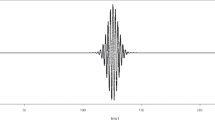Abstract
The exactly solvable Keldysh model of disordered electron system in a random scattering field with extremely long correlation length is converted to the time-dependent model with extremely long relaxation. The dynamical problem is solved for the ensemble of two-level systems (TLS) with fluctuating well depths having the discrete Z 2 symmetry. It is shown also that the symmetric TLS with fluctuating barrier transparency may be described in terms of the vector Keldysh model with dime-dependent random planar rotations in xy plane having continuous SO(2) symmetry. Application of this model to description of dynamic fluctuations in quantum dots and optical lattices is discussed.
Similar content being viewed by others
References
L. V. Keldysh, Doktoral Dissertation (Lebedev Institute, Moscow, 1965).
A. A. Abrikosov, L. P. Gorkov, and I. E. Dzyaloshinski, Methods of Quantum Field Theory in Statistical Physics (Prentice-Hall, Englewood Cliffs, NJ, 1963).
A. L. Efros, Zh. Eksp. Teor. Fiz. 59, 880 (1970) [Sov. Phys. JETP 32, 479 (1971)].
M. E. Raikh and T. V. Shahbazyan, Phys. Rev. B 47, 1522 (1993).
M. N. Kiselev, K. Kikoin, Y. Avishai, and J. Richert, Phys. Rev. B 74, 115306 (2006).
M. V. Sadovskii, Diagrammatica (World Sci., Singapore, 2005).
\( (2n - 1)!! = 2^n \frac{1} {{\sqrt \pi }}\Gamma (n + 1/2) = \frac{1} {{\sqrt {2\pi } }}\smallint _{ - \infty }^\infty dtt^{2n} e^{^{ - \frac{{t^2 }} {2}} } \).
The correlators \( \overline {\Delta (t)\Delta (t + \tau )} \) and \( \overline {\Delta *(t)\Delta *(t + \tau )} \) are transformed under “local” time-independent gauge transformation and therefore average to zero according to Elitzur theorem [S. Elitzur, Phys. Rev. D 12, 3978 (1975)].
\( n! = G(n + 1) = \smallint _0^\infty dzz^n e^{ - z} \).
M. N. Kiselev, K. Kikoin, and J. Richert, arXiv:0803.2676; Phys. Stat. Solidi (c) (in press).
M. N. Kiselev and K. Kikoin (unpublished).
M. N. Kiselev and Y. Gefen, Phys. Rev. Lett. 96, 066805 (2006).
I. L. Kurland, I. L. Aleiner, and B. L. Altshuler, Phys. Rev. B 62, 14886 (2000).
P. Cheinet, S. Trotzky, M. Feld, et al., Phys. Rev. Lett. 101, 090404 (2008).
Author information
Authors and Affiliations
Corresponding author
Additional information
The article is published in the original.




